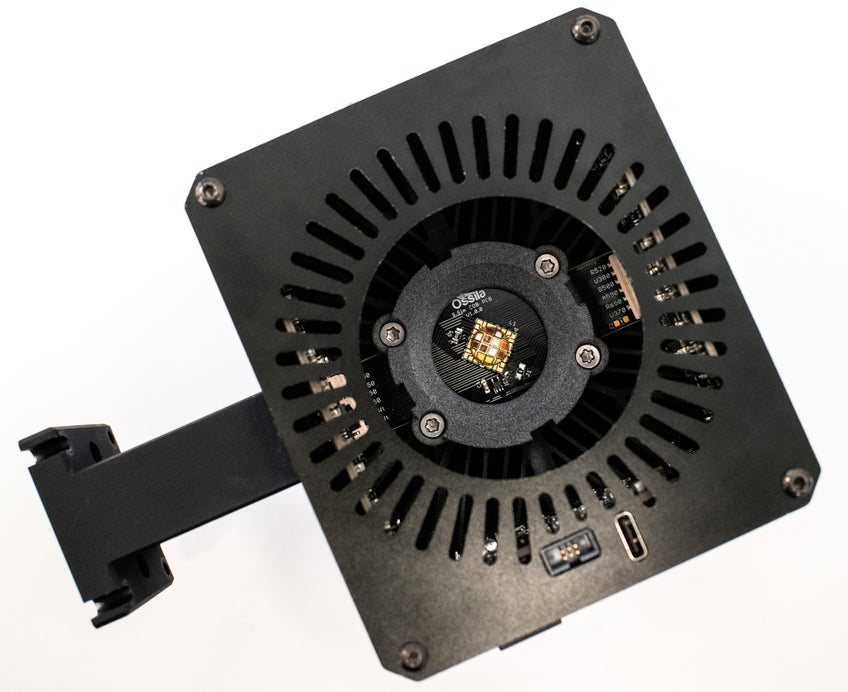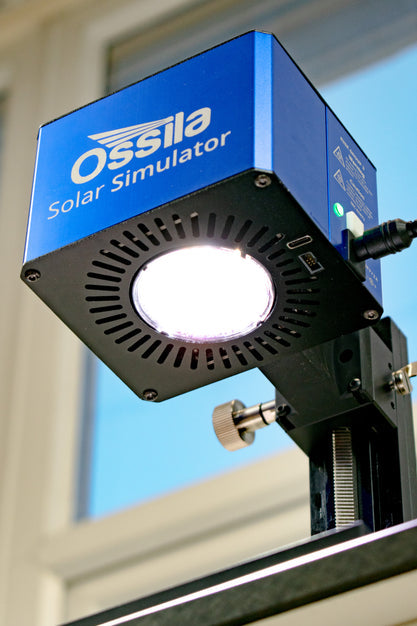Solar Simulator Light Sources

Choosing the right light source for your solar simulator is one the most important decisions to make when you are setting up a PV testing laboratory. The short circuit current, JSC, is determined by the equation below.
Here, EQE is external quantum efficiency which represents the ability of a material to convert a photon into an extracted electric charge. The former coefficient, b, represents the incoming flux of photons hitting the device. Essentially, the current produced in your solar cell will vary directly with the intensity of light hitting your device. This is why it is so important to accurately replicate the solar spectrum when measuring your device efficiency.
In sum, the inconsistent nature of natural sunlight (due to weather conditions, geographical variability, etc) makes using actual sunlight for comparable solar cell testing very difficult. Therefore, solar simulators are often used in solar irradiance experiments.
The light source within a solar simulator must meet two criteria: it must have a consistent output and it must accurately replicate the solar spectrum (either AM1.5 or AM0). Solar testing systems therefore need a calibrated lamp, which is designed to mimic both the suns power density and its spectral distribution. However, there are also other factors to consider when choosing a solar simulator for your solar cell laboratory such as:
- Solar simulator classification
- Initial and Maintenance Costs
- Lamp Lifetime
- Associated hazards
- Available wavelength range
The Ossila Solar Simulator uses an LED array lamp due to the many attractive properties associated with these light sources.
Types of Light Source for Solar Simulator
Xenon Arc Lamp
Xenon arc lamps are the most commonly used light source for solar simulators. In Xenon arc lamps, light is produced by passing an electric arc through ionized xenon gas under high pressure (10 – 40 bar). Xenon has a color temperature of ~6000 – 6200 K which allows for excellent replication of the suns spectrum (5800 K). These lamps have great spectral properties in the UV and visible light wavelengths, providing good spectral match up to 750 nm. Additionally, these lamps act as a very bright point source so can be used in high intensity beams. However, xenon lamps do exhibit strong emission lines in the IR (800 – 1000 nm) which need to be filtered out to represent natural sunlight more accurately.
Despite being the unofficial standard for solar simulator light sources, there are some negatives to using xenon lamps.
- They have a short lifetime. Xenon arc lamps begin to show a spectral shift from UV to the IR after 200 – 1000 hours usage.
- Although there is no spectral shift due to changing power supply, the output intensities vary depending on power supply. It is therefore very important to maintain a constant power supply to these lamps, which can require a complex and expensive power source.
- They also have increased levels of power consumption compared to other light sources, which increases usage cost.
- The Xenon gas is held at high pressure, so there is a risk of lamp explosion. This is true for most arc lamp sources.
- It can take a significant amount of time (30 minutes – 1 hour) for the lamp to "warm up" and produce a consistent spectral output.
- Xenon arc lamps are quite expensive light sources.
LEDs
The idea of an LED solar simulator lamp was first introduced in 2003, and they have since become an attractive choice for solar simulator light sources. This is especially the case as the achievable light intensity of LEDs has increased. LEDs are semiconductor materials that emit light at a particular wavelength when a current is passed through them. LED solar simulator lamps use an array of multiple narrow broadband LEDs, combined using carefully calibrated optics, to create your desired spectrum. In general terms, the more LEDs that you use, the better you can closely replicate your desired spectrum.

LED lamps can produce a high-quality solar spectrum, matching that of Xenon lamps between 350 – 1000 nm. However, LED lamps are also comparatively compact, low-cost and have an especially low power consumption. Additionally, you can easily control the output from LED solar simulators by varying the power output to the LEDs, either as a whole array or by controlling individual LEDs. This also means you can vary the output spectrum to suit your purposes (i.e. to replicate an indoor light spectrum). LEDs also require a much shorter "warm up" time to reach a consistent solar output, allowing for the fast and easy control of your solar simulator. This can be especially useful for "flash"-testing of solar devices, as well as steady-state testing.
There are some limitations to using LED lamps. First, spectral range is generally limited to 1000nm. Therefore, there is a trade off when using more LEDs in your lamp to increase spectral matching. Additionally, performance can vary with operation temperature in LEDs. Therefore, LED lamps require an efficient cooling system to maintain good operational conditions. Just like with the other light sources, the quality of spectrum may degrade over their lifetime. Although, the lifetime of LED lamps is generally much longer than for arc lamp sources (estimated lifetimes vary between 10,000 – 50,000 hours).
Carbon Arc Lamp
The carbon arc lamp was the first example of an electric lamp made available for commercial usage. While they produce a very bright light that can be used in solar simulation, carbon arc lamps are often used for extra-terrestrial solar simulation or space-simulation as their spectrum aligns more with the AM0 spectrum than AM1.5. Additionally, these have historically been used to measure the fading of textile materials.
However, carbon arc lamps are quite unstable, and their spectrum is quite different to the solar spectrum. Most of the light produced by a carbon arc lamp is in the UV and blue light region. Additionally, the produced spectrum varies with each measurement. For these reasons, they are not currently a common choice for solar simulator lamps.
Argon Arc lamp
Argon arc lamps use an electric arc in pressurized argon gas which is held at 5 – 10 bar pressure. These were historically used as solar simulators in the 1970s. They show good irradiance stability and temporal consistency, as well as a reasonable spectral match to AM1.5. However, a better spectral match can be achieved today with more stable materials such as xenon lamps or LED simulators.
Quartz Tungsten Halogen Lamp
Quartz tungsten lamps are used mainly as infrared light sources. You can use quartz-tungsten halogen lamps to measure PV materials, but other light sources may be more correct in the visible and UV regions. However, they are low cost, and produce high intensity light with good spectral interval. They are also relatively easy to maintain. Therefore, you can combine these with other light sources to make a good solar simulator.
Metal Halide Lamp
Metal halide lamps are becoming a more popular choice of solar simulator because they have longer lifetimes, balanced spectral qualities and are less expensive than xenon lamps. However, the relative emissions at different wavelengths are weighted unfavorably, with more light produced in the UV compared to the IR. They also have a similar risk of explosion as xenon lamps, as they are held at very high pressures.
Multiple Light Source Simulator
To create a broader spectral match, some researchers combine multiple light sources within one solar simulator. Examples of this include metal halide light source in conjunction with a quartz halogen lamp light source. Alternatively, xenon lamps and LED lamps can be combined with tungsten lamps to further the spectral range further into the IR.
Why Choose an LED Light Source for your Solar Simulator?

The Ossila Solar Simulator Lamp uses multiple LEDs to achieve a AAA classification (IEC 60904-9:2020 International Standard), over a small device area. There are many reasons to choose an LED-solar simulator for your lab.
LED lamp advantages:
- You can create a high-quality solar spectrum by using multiple tuned LEDs.
- They have an exceptionally long operational lifetime (10x longer on average compared with most arc lamps).
- They have compact dimensions and are easy to set up, so you can adapt them into any lab space.
- They have a short warm-up time. This is especially the case compared to Xenon sources which are usually left on for 30 mins – 1 hour before use.
- There is no threat of lamp explosions due to high pressure, and no threat of risk of ozone build up.
- You can change spectral distribution by varying individual LED intensities. This is useful if you are replicating light sources besides the solar spectrum, for example creating an "indoor light" spectrum to test electronic devices/solar cells which will be used indoors.
- You can vary the overall light intensity from 10%-100% of 1 Sun by changing your power supply to the LED array. You can further reduce this by increasing the distance between your device and the solar simulator. This is quite easy to do using the Ossila modular solar testing package. This is useful for light intensity studies, where you can measure recombination mechanisms within your PV device.
- LED lamps are low cost to buy, maintain and replace, especially in comparison to arc lamp systems.
Solar Simulator

Learn More
 How to Set Up a Solar Simulator Light Source
How to Set Up a Solar Simulator Light Source
The solar simulator light source is compact, lightweight and can be easily installed in any lab using adjustable height stand provided with it.
Read more... How to Check Solar Simulator Calibration
How to Check Solar Simulator Calibration
It is important to ensure that your solar simulator is outputting a consistent spectral output. Different solar simulators will have different bulb lifetimes.
Read more...References
- Deepak, Srivastava, S., & Malvi, C. S. (2020). Light sources selection for solar simulators: A Review. WEENTECH Proceedings in Energy, 28–46. DOI: 10.32438/wpe.060257
- Krebs, F. C., Sylvester-Hvid, K. O., & Jørgensen, M. (2010). A self-calibrating LED-based Solar Test Platform. Progress in Photovoltaics: Research and Applications, 19(1), 97–112. DOI: 10.1002/pip.963
- Leary, G., Switzer, G., Kuntz, G., & Kaiser, T. (2016). Comparison of xenon lamp-based and LED-based solar simulators. 2016 IEEE 43rd Photovoltaic Specialists Conference (PVSC). DOI: 10.1109/pvsc.2016.7750227